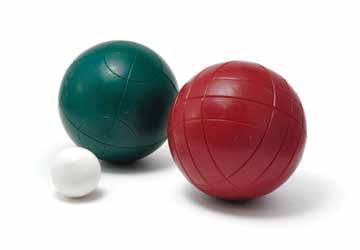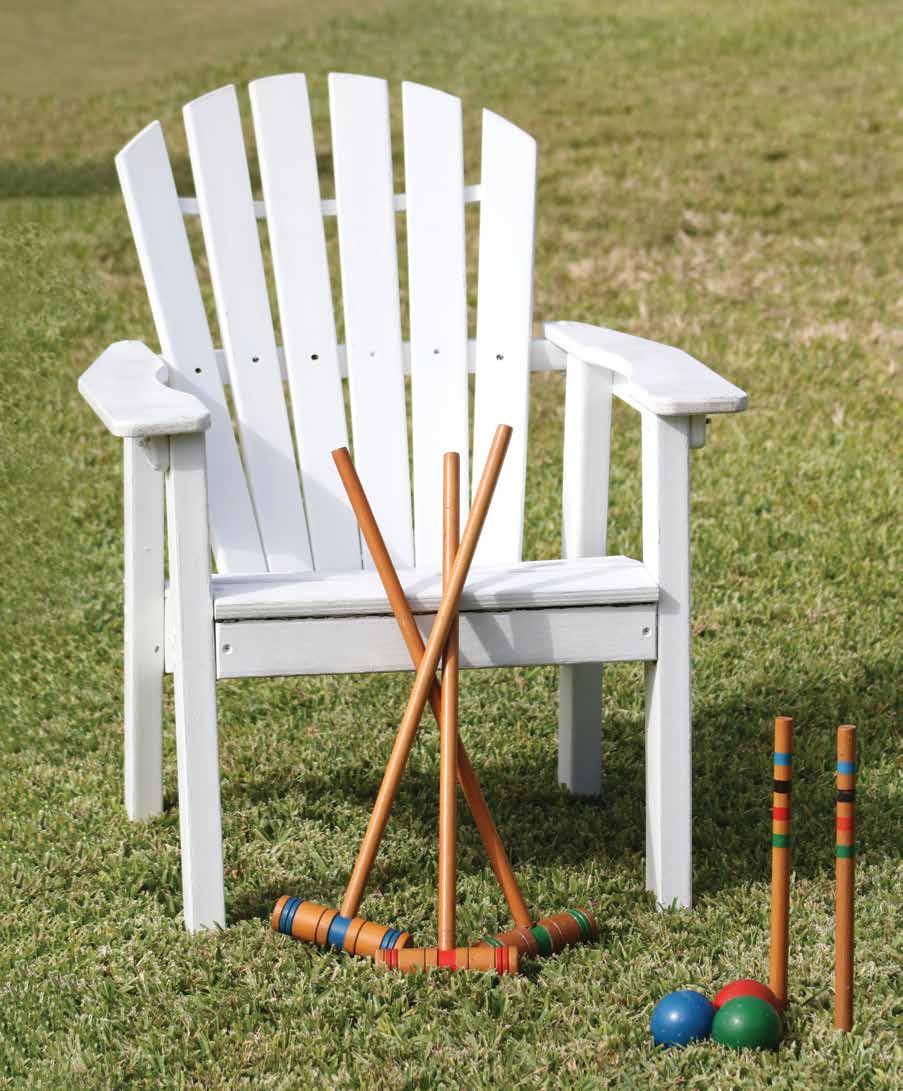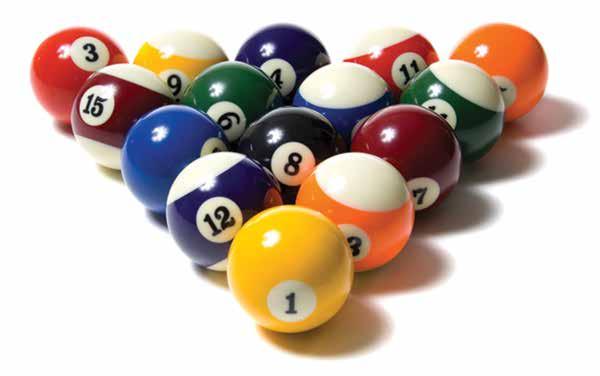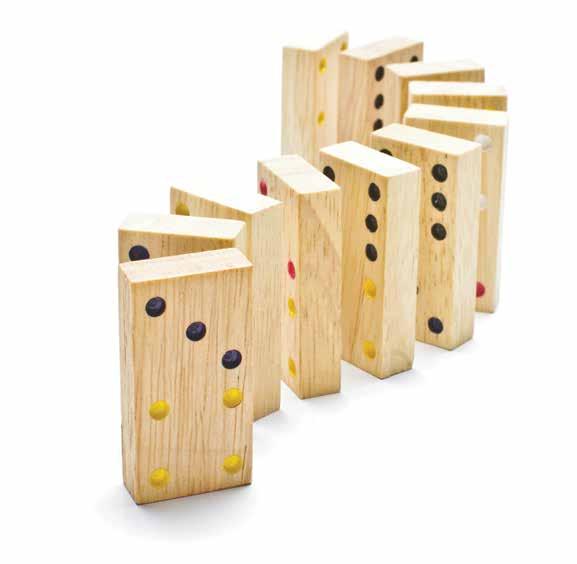
20 minute read
All Fun and Games
verybody is a kid at the holidays so we thought we’d spotlight games in this issue. Social interaction has involved play since the beginning of time. Rocks, wood, sticks, and animal bones and skins were all used creatively as toys and implements of play. From outdoor fun to parlor games, games played at the kitchen table to those enjoyed at the pub, competitive sport to children’s pastimes, there are a wide variety of games that have developed and evolved through the years that still entertain today. When you’re out doing your holiday shopping, don’t forget to include the board games or maybe a croquet set for the backyard! As the family gathers to enjoy the Christmas spread, instead of watching everyone on their phones or sitting in front of the TV, engage them in a round of bocce at the beach or some hot and heavy Scrabble competition.
The inspiration for this piece, ironically, did come from sitting and looking at a screen and discovering that the Jekyll Island Croquet Club was having a Wine, Wicket Wednesday monthly social where everyone is invited to attend to learn more about the game, the basics of play, and are encouraged to join in a friendly game of golf croquet with members. Of course, just the image of people gathered in white holding mallets to strike the colorful balls through wickets on the green lawn in front of the beautiful backdrop of the Jekyll Island Club Hotel stirs a sense of nostalgia. Right here in this very place, the Astors, Morgans, Goulds, and Rockefellers who founded the Club in the late 1800s may have been swinging mallets of their own on a lazy winter afternoon. It’s not hard to imagine at all.
Jekyll Island Club was created as a private winter hunting retreat, and as it grew, other outdoor leisure activities became popular with members. The first golf course was built on Jekyll Island in 1898, just north of the Club compound. Tennis courts, a swimming pool, bocce, and croquet lawns followed. Golf become the dominant sport of the Club and a second oceanside course was added in the 1920s. It’s easy to picture the ladies with their parasols, herding their children around the well-manicured lawns, while the dapper men in their caps made wagers over friendly outdoor tournaments. But unlike golf, croquet did not remain a mainstay of the Jekyll Island Club during the years of its evolution into today’s resort.
Jekyll Island Croquet Club President John Donohue explained to me that the current croquet lawn didn’t come about until the 1980s when the sport experienced a renaissance and the new owners developed an interest. But, perhaps before you hear about the renaissance and modern play, you should know a little more about the history of the game.
“Croquet is believed to have been first played by thirteenth century French peasants who used crudely fashioned mallets to whack wooden balls through hoops made of willow branches.” According to the Croquet Foundation of America. However, the origins of the modern game have been traced back a game called “crooky” that was played in Ireland since the 1830s was introduced in England around 1852. The game’s popularity spread when John Jaques, a London sporting goods manufacturer began selling croquet sets. By 1870, croquet was one of the primary social and recreational activities of the leisure class in
- CROQUET -
Britain and had spread to virtually all of its colonies as well. Growth waned with the introduction of lawn tennis and the onset of World War I, but it regained its popularity in the 1930s and 40s. After World War II, toy makers began marketing croquet as a backyard children’s game with miniaturized sets and simplified rules. In the late 1970s, croquet began its revitalization as a competitive sport and has continued to grow in popularity throughout North America since that time.
The informal backyard version of croquet is usually played with nine wickets and two stakes as friendly competition between friends and family under “house rules” on less than perfect grassy terrain. This game remains incredibly popular, with more than an estimated 100,000 backyard croquet sets sold each year.
The sport version of croquet is played competitively in more than twenty countries and is currently experiencing a dramatic revival, even here locally. The sport’s growth can be largely attributed to the efforts of international and national croquet organizations such as Croquet Canada and the United States Croquet Association. Since the early 1980s the number of (continues)
Competitive croquet is played with six wickets and one stake in the center of the court. The “six-wicket” game offers the player the opportunity to learn more advanced shot-making techniques and strategies than the backyard version. Equipment is also more advanced than the standard backyard set. Balls weigh one pound each and have only an eighth of an inch clearance through the uprights, which are iron or steel precision wickets. Fine wood is used for most mallets, which are weighted depending on the needs of the player. While you may see some with cylindric heads (like in your typical backyard set), mallets with square heads are popular for their convenience – they stand upright when a player sets them down. The variety in mallets is similar to variety in golf clubs with players choosing comfortable shaft height, and the balance and weight of the club that suits them. Men and women compete on an equal playing level without separate divisions and the sport can be played by all ages. Divisions in competitive play only exist among skill levels.

Yet another version of the game, and the one we observed on Jekyll, is Golf Croquet. Equipment and order of wickets is the same as in six-wicket play, but only one ball goes through any one wicket, earning one point for its shooter, with shooters alternating. The players advance to the next wicket, with a winning score usually being the first player or team to achieve seven points. As Donohue explained, this is a much more social and entertaining game for non-competitive play because players can play immediately, and think more about shot making than the more complex strategy involved in the six-wicket game. However, because of its ease and fast pace, it is becoming popular in competitive play tournaments as well. The US Croquet Association fosters croquet in all its forms.
A fantastic way to learn the game is to come out for the monthly socials hosted by the Jekyll Island Croquet Club. Like the game itself, the Club has also gained popularity and is currently one of seven regional clubs, with about 400 players in the SGA/NFL area. They meet on Tuesdays for six-wicket club play, and on Wednesdays from 3:00-5:00 p.m. for less formal games of golf croquet, to which all are welcome without committing to lessons or fees. Members of the Jekyll Island Croquet Club must also join the Jekyll Island Hotel annually for access to the court. Croquet lessons are available through the Jekyll Island Arts Association. Please email John at jfd9089@gmail.com for more information.
- BOCCE -
Another old-fashioned “lawn game” you’ll commonly see in the Golden Isles is bocce. Here, of course, you’ll mostly see it being played on the beach in casual social settings, but there are some more serious competitors on the island too! Bella Italia of the Golden Isles, our local social organization dedicating to preserving, promoting, and celebrating Italian culture and traditions, has a bocce league and was instrumental in having the bocce ball court built at Epworth Park. This, if you know the game’s history, is only fitting.
Throwing balls toward a target is the oldest game known to mankind and is the origin of the game of bocce. There are recorded representations of figures tossing balls or polished stones that date back as early as 5200 B.C. And while today’s game of bocce differs distinctly from its early origins, the game’s objective has always been to try to come as close to a fixed target as possible. It’s estimated that the game made its way from Egypt to Greece around 800 B.C. It was the early Romans who learned the game from the Greeks and were among the first to play a game resembling what we now know as today’s game of bocce. Beginning with Emperor Augustus, Bocce became the sport of statesman and rulers. Coconuts brought back from Africa were initially used for balls, and later they were carved from hard olive wood.
Bocce enthusiasts and historians say that early participants and proponents of the sport included Greek physician Hippocrates and the Italian Renaissance figure Galileo. They noted that the athleticism and spirit of competition of the game was helpful to rejuvenate the body. Yet, as the game’s popularity grew, while it might have been considered healthy for the body, it had just the opposite effect the state of the nation. Bocce was prohibited because it interfered with military training and security of the state. It was publicly condemned by the Republic of Venice in 1576, and condemned by the Catholic Church as well. In Great Britain, however, the game thrived with Queen Elizabeth I and Sir Francis Drake being among its avid fans.
Italian nationalist Giuseppe Garibaldi is credited with popularizing the sport as it is known today. In 1896, the first Bocce Olympiad was held in Athens, Greece and bocce has been a part of international sports ever since. It was an English version of the sport called “Bowls” that first introduced the sport in America. Balls were thrown not on stone dust (as is done today) but on close cropped grass lawns (you’ve heard of Bowling Green, right?!). The first modern bocce clubs were organized in Italy, with the first Italian League being formed in 1947 by fifteen teams in and around the town of Rivoli (Torino). That was the same year of the first Bocce World Championship, a tournament which continues today with participants from more than 30 nations, including the US. It was thanks to the many Italian immigrants at the turn of the century that bocce became popular in America. Currently it’s estimated that there are more than 25 million bocce enthusiasts throughout the United States and the sport ranks with golf and soccer as having the most participants worldwide. (continues)



- POOL/BILLIARDS -

Whether you choose to call it “pool” or “billiards,” the history of the game is long and rich and there’s likely someone playing at a table here in the Golden Isles every weekend. Surprisingly, tracing the lineage of billiards brings us back to where we began.
Billiards is thought to have evolved from a lawn game similar to croquet played in the 15th century in Northern Europe and likely France as well. Due to cold or intemperate weather, play moved indoors to a wooden table with a green cloth to simulate grass and a simple border was placed around the edges as a bumper. Instead of today’s cue, which is used to strike the ball, players pushed the balls with wooden sticks called “maces” or “billarts” in French. While early billiards may have been mostly played by nobles, public billiard tables were common by 1800. The cue stick was developed sometime in the 1600s, with the leather cue tip perfected in 1823, and the two-piece cue arriving in 1829. Billiard equipment improved rapidly following the Industrial Revolution and by 1850, the billiard table had essentially evolved into its current form.
While English and American billiards games differed, the word “pool” became attached to pocket billiards. Pool tables were often installed in betting parlors for horse racing to pass the time between races. For some, this connection with betting gave the “poolroom” an unsavory connotation. Eight-Ball was invented shortly after 1900, Straight Pool around 1910, and Nine-Ball developed about a decade later. Billiards refers to all games played on a billiard table (with or without pockets). Billiards remained popular from the late 1800s until the mid-1950s when men who returned from the war no longer spent afternoons around a pool table, but focused on building careers.
The renaissance of the game can largely be attributed to two movies: The Hustler in 1961, and The Color of Money in 1986. New, upscale pool rooms opened and interest in the game and competitive play returned. You can find tables at a number of establishments in the Golden Isles. Murphy’s Tavern is the choice of EIL readers for Best Place to Play Pool, but there are tables at Castaways, Ziggy’s, and Rafters as well.
- BRIDGE -
Having fun indoors was not a novel idea, card, board, and parlor games have been around long before billiard tables came about. Playing cards originated in China, where paper was invented, around the year 1120 and were first used for fortune telling and gambling. Cards were introduced into Italy and Spain around 1370, probably coming from Egypt. Tarot cards, used for fortune telling, were introduced in Italy in 1440. The French suits were introduced around 1480 and became popular in English playing cards in the 16th century.
One of the most popular card games worldwide, especially among seniors, is bridge. The game of bridge was derived from Russian whist, with books on whist dating back to the mid-1700’s. Here in the US, historians have noted that George Washington enjoyed bridge, often making small wagers on the game to make it more exciting. The “duplicate” method of play was introduced in England in 1857, to eliminate most of the luck associated with the deal of the cards. Inner-club match play began in America around 1883. In 1891 came the invention of the duplicate tray used to hold the cards separately so players could replay the identical cards. The idea was to eliminate chance and provide a true test of skill. By 1893, bridge was introduced in New York, using formal rules that were printed by Henry Barbey. Sometime around (continues)
1904, auction bridge was developed, in which the players bid in a competitive auction to decide the contract and declarer. The object became to make at least as many tricks as were contracted for, and penalties were introduced for failing to do so.
Major changes to scoring and the game of bridge were introduced in 1925, and interestingly, here in the history of the game, we have another connection to the Jekyll Island Club era and its founders. Harold Stirling Vanderbilt, a railroad executive and the son of William K. Vanderbilt, a member of the Club from 1886-1902 (and nephew of Cornelius Vanderbilt II, another Club member) was a champion yachtsman as well as an innovator and champion player of contract bridge. While on board the cruise ship SS Finland in 1925, he originated changes to the bridge scoring system to make the game more exciting. His version of “contract bridge” overtook auction bridge in popularity within a few years and “bridge” became synonymous with contract bridge. Vanderbilt invented the first strong club system, which he called the “Club Convention” but is now more commonly known as the “Vanderbilt Club,” a family of bidding systems that has performed exceptionally well in world championship play. He wrote four books on the subject. He endowed the Vanderbilt Cup which is awarded to the winners of the North American team-of-four championship. He also donated the World Bridge Federation Vanderbilt Trophy. Vanderbilt was a member of The Bridge World’s 1964 inaugural “hall of fame” class and a founding member of the ACBL Hall of Fame.
Contract bridge is played in clubs, tournaments and online today. When its popularity peaked in the 1940s, a survey found that the game was played in 44% of US households. While the popularity of bridge has declined, it’s estimated that in the US there are still several million players. The game is most definitely alive and well on Skylane Court on St. Simons Island, at the home of the Golden Isles Duplicate Bridge Club. This American Contract Bridge League-sanctioned club offers friendly and competitive duplicate contract bridge to players of all levels and can find you a partner with whom to pair if you’re visiting or new to the area and want to join a game. They also offer lessons and instruction for players of various skill levels. See bridgewebs.com/goldenisles/ for more information.
- DOMINOES -
Another game with origins in ancient China is dominoes. Domino tiles, also known as “bones,” were often carved from bone, ivory, or dark hardwoods with the dots or “pips” marked in a contrasting color. The Chinese 32-piece set of tiles was made to represent each possible face of two thrown dice, and had no blank faces. Several different types of sets have arisen since then with both blanks and duplicates. Modern dominoes first appeared in Italy in the 18th century. A wide variety of games can be played with domino tiles and numerous different sets exist, with most commercially sold sets being double-six with 28 tiles and double-nine with 55 tiles. Like with playing cards, dominoes are incredibly versatile and can be used to play numerous games of varying simplicity and complexity, making them perfect for creating family games tailored to allow even the youngest players to participate. (continues)

COSMETIC & FAMILY DENTISTRY
Highly Recommended. Highly Referred. Accepting New Patients.
912.638.9946 300 Main St. #102 bryandentalssi.com

Did You Know?
Backgammon is one of the oldest games known in existence. There is evidence of dice made of human bones and 60 relic game pieces being found in the 5,000 year old civilization called “Burnt City” in southeast Iran. And, the emperor Nero played for today’s equivalent of $10,000 a game. If philosophers, scholars, kings and presidents have played the game, why not you?


But when we think of tile games and social play, it’s an American classic that first comes to mind for this writer. It may be less than a century old, but more than a billion Scrabble® games have been played in that time. The game’s website says that more than one hundred million sets have been sold worldwide and between one and two million are sold each year in North America.
Scrabble’s history is a great American tale. In the 1940s, an out-of-work NY architect, Alfred Mosher Butts, decided to invent a board game.
He found that board games fell into three categories: number games, such as dice and bingo; move games, such as chess and checkers and word games, such as anagrams. Butts combined features of anagrams and crossword puzzles in an attempt to create a game that would use both chance and skill. To decide on letter distribution, Butts studied the front page of The New York Times and did painstaking calculations of letter frequency. That basic cryptographic analysis of our language and Butts’ original tile distribution have remained valid to this day.
Butts faced rejection across the board in his quest for commercial development until he met James Brunot, a game-loving entrepreneur. Together, they refined the rules and design and came up with its name. The game
was trademarked Scrabble ® Brand Crossword Game in 1948. Initially, the Brunot family rented an abandoned schoolhouse in Connecticut where, with friends, they turned out 12 games an hour, stamping letters on wooden tiles one at a time. Later, boards, boxes and tiles were made elsewhere and sent to the factory for assembly and shipping.
The initial years were a struggle, with the Brunots making only 2,400 sets and ending up with a loss of $450 in 1949. The game was gaining slow but steady popularity among consumers, however. The tide turned in the early 1950s when, as legend has it, the president of Macy’s discovered the game while on vacation and ordered some for his store. Within a year, everyone “had to have one” to the point that Scrabble games were being rationed to stores around the country. By 1952, the Brunots realized they could no longer make the games fast enough to meet the growing interest and had to hire a manufacturer to step up production, market and distribute the games. Popularity and demand continued to grow and in 1972 the Brunots sold the trademark. Hasbro, Inc., owner of Milton Bradley Company, the nation’s leading game company, now produces and markets the Scrabble games in its various editions. It is estimated that the game is found in one of every three American homes (continues)

FUN FACT: The board game Clue was originally named Murder! and was created to pass the time during the war when troops were stuck in underground bunkers during long air raid drills.

and competitive Scrabble game play has also become widely popular similarly to chess and bridge. Every year, a National Scrabble Championship is held in a major US city, and on alternate years the World Scrabble Championship is hosted between Hasbro and Mattel. In addition, the National Scrabble Association sanctions over 180 tournaments and more than 200 clubs in the US and Canada. There is even a School Scrabble Program with over a half million kids playing the game in more than 18,000 schools nationwide. Hundreds of these students compete in state and regional championships across the country.
Scrabble should be a mainstay of any family game night, allowing for limited vocabulary of younger players. Pull out your board and tiles, add in some other classics like
Jenga, Sorry, Trouble, Life, Clue, and
Monopoly, and you have a full weekend of fun around the table!

- JACKS -
Don’t forget the fun of the simple classics either! How about a game of jacks?! There’s nothing more fun than seeing the kids try to best mom or dad with their dexterity in scooping up pieces while the ball bounces.
Another game with ancient origins, this time traced back to Greece, jacks was originally known as “knucklebones” for the sheep’s bones that were used as game pieces. The game was also played with stones, with one stone being tossed in the air, while the others were scooped up from the ground or table. Modern sets have a rubber ball and 10 jacks, usually plastic or metal. There are variations in play, but the main objective is still to pick up the most number of jacks in a single bounce of the ball through several rounds of play.
A set of jacks is a terrific stocking stuffer! Younger kids will love to play the game and adults appreciate the nostalgia.
No matter what game you choose, inside or out, put down those smartphones, step away from the TV and the gaming consoles, grab your family and friends and get to playing! It’s time to reclaim the “social” from social media and bring people together for a good time. Enjoy the holidays! Ready, set … PLAY!

Award-Winning, Southern Cooking That will Bring You Back
Because Barbara Jean’s and her family know how to get it done, just ask Coastal Living, Southern Living, Georgia Trend …
Best of 2017
Bread & Rolls, Crab Cakes, Southern Cooking, Soup, Vegetable Plate Selection
Crab Cakes, She Crab Soup, Cornbreads And More Can Be Shipped From Our Online Store. Makes a Great Gift!










